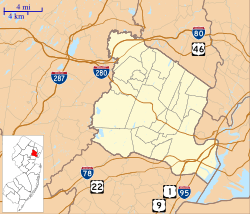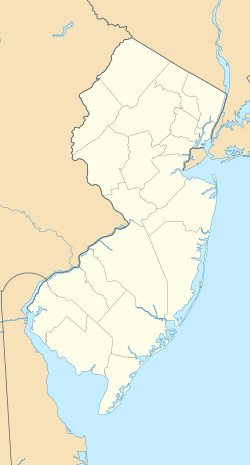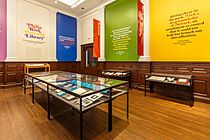Newark Public Library facts for kids
Quick facts for kids The Newark Public Library |
|
|---|---|
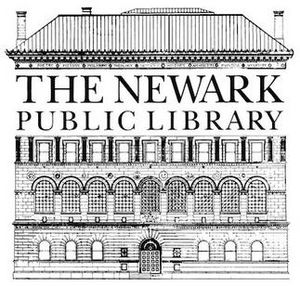 |
|
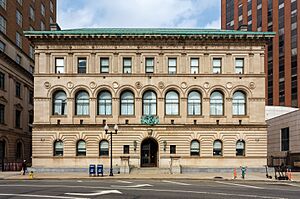 |
|
| Location | Newark, New Jersey, USA |
| Branches | 6 (Weequahic, Van Buren, Vailsburg, North End, Branchbrook, Springfield), 4 closed branches |
| Collection | |
| Size | 1,691,042 |
| Access and use | |
| Circulation | 164,022 |
| Population served | 281,402 |
| Members | 72,605 |
| Other information | |
| Budget | $11,351,129 |
| Staff | 98 |
| Website | www.npl.org |
|
James Street Commons Historic District
|
|
|
U.S. Historic district
Contributing property |
|
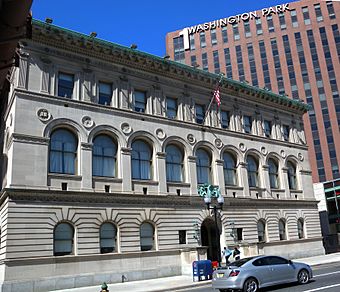 |
|
| NRHP reference No. | 78001758 |
|---|---|
| Significant dates | |
| Added to NRHP | January 9, 1978 |
The Newark Public Library (NPL) is a public library system in Newark, New Jersey. It's a place where everyone can find books, learn new things, and enjoy fun events. The library has seven different locations and serves as a special Statewide Reference Center for New Jersey. It has a huge collection of books, art, and history exhibits. The library also offers many programs for people of all ages. Famous author Philip Roth's personal book collection is kept here.
Contents
Discovering Library Locations
The Newark Public Library has several branches across the city. Each branch helps people in its local neighborhood. The main library is a large building in downtown Newark.
Main Library and Branch Locations
| Name | Address | Website | Opening Date |
|---|---|---|---|
| Branch Brook Branch | 235 Clifton Avenue | https://npl.org/community-libraries/branch-brook-branch/ | 1946 |
| Main Library | 5 Washington Street | https://npl.org/main-library/ | 1901 |
| North End Branch | 722 Summer Avenue | https://npl.org/community-libraries/north-end-branch/ | 1930 |
| Springfield Branch | 50 Hayes Street | https://npl.org/community-libraries/springfield-branch/ | 1923 |
| Vailsburg Branch | 75 Alexander Street | https://npl.org/community-libraries/vailsburg-branch/ | 1927 |
| Van Buren Branch | 140 Van Buren Street | https://npl.org/community-libraries/van-buren-branch/ | 1923 |
| Weequahic Branch | 355 Osborne Terrace | https://npl.org/community-libraries/weequahic-branch/ | 1929 |
Past Library Branches
Some library branches have closed over the years. This happened for different reasons, like budget cuts or building issues.
| Name | Address | Closed | Reason |
|---|---|---|---|
| First Avenue | 282 First Ave | 2010 | Budget cuts, Great Recession |
| Madison | 790 Clinton Ave | 2010 | Budget cuts, Great Recession |
| Roseville | 99 Fifth St | 2009 | Budget cuts, Great Recession |
| Clinton Branch | 739 Bergen St | 2021 | Building problems |
The Library's Journey Through Time
The Newark Public Library has a long and interesting history. It started as a private group in 1847. Then, in 1887, the people of Newark voted to create a free public library for everyone.
Early Days and New Buildings
The first Free Public Library opened in 1889 on West Park Street. It had over 10,000 books. Soon, the library needed more space because it had more books and more people using it. A new main building opened in 1901 at 5 Washington Street. This building is still the main library today. It was designed to look like a beautiful 15th-century palace in Florence, Italy. The library was also used as a museum and a place for talks and art shows.
John Cotton Dana's Vision
In 1902, John Cotton Dana became the library's director. He believed libraries were very important for education. He started collections of books in different languages for immigrants. He also created a special "Business Branch" for the business community. This was the first of its kind in the country! John Cotton Dana also started the Newark Museum inside the library in 1909. He led both until he passed away in 1929.
Growing Collections and Services
After Dana, Beatrice Winser became the director until 1942. In 1930, the library even had a book truck that brought books to children around Newark. The library also started its New Jersey Collection in 1929. This collection later became the Charles F. Cummings New Jersey Information Center. In 1963, the library became a Federal Regional Depository. This means it keeps many important government documents.
Connecting with the World
The Newark Public Library was one of the first U.S. libraries to start lending books to other countries again after World War II. This helped libraries in North America reconnect with libraries around the world.
Facing Challenges and Finding Support
The library faced challenges, including threats of closure in the 1960s. During this time, the city was going through big changes. Luckily, federal funding helped the library stay open. When it was threatened again in 1969, people in the community worked together. They put pressure on the government to get more money for the library, and it stayed open.
Expanding Cultural Collections
In 1989, the library opened the James Brown African American Room. This room helps people learn about and appreciate African American history and culture. Also in 1989, La Sala was created. It has the largest collection of Spanish-language books in New Jersey. In 2002, the library worked with a Latino community group to create the New Jersey Hispanic Research and Information Center (NJHRIC).
Digital Access and News
In 2018, the library launched a digital collection online at digital.npl.org. This lets people access many resources from home. In 2024, the library scanned the Newark Evening News, a historic newspaper from Newark.
Important Sections of the Main Library
The Main Library has many special departments, each focusing on different topics.
- The Reference Center helps you find information on almost any subject. It's a statewide center for libraries needing help with art, business, music, patents, and government documents.
- The Charles F. Cummings New Jersey Information Center is all about New Jersey. It has unique collections of books, photos, and historical records about Newark and New Jersey.
- The New Jersey Hispanic Research and Information Center includes La Sala Hispanoamericana, which has the biggest collection of Spanish-language books in New Jersey. It also has the Hispanic Reference Collection and the Puerto Rican Community Archives.
- Special Collections holds amazing rare books, art books, and fine prints. It was started by John Cotton Dana in 1902. This department helps people study visual arts and learn about graphic arts.
- The James Brown African American Room was created to collect and share the history, culture, and achievements of African Americans.
- Other areas in the main library include the Children's Room, Teen Room, LGBTQ Center, and Special Services Room.
- The Philip Roth Personal Library holds about 7,000 books that belonged to author Philip Roth. It also has an exhibit about his life. Philip Roth gave money and many of his belongings to the library when he passed away in 2018. His collection includes his letters, photos, travel plans, typewriters, and books with his own notes. He said he did this because he was grateful to the city where he was born. This special library opened to the public in 2021.
The Main Library's Design
The Main Library building has four floors and was designed by John Hall Rankin and Thomas M. Kellogg. They were inspired by a 15th-century palace in Florence, Italy. They wanted the building to be more than just a library. They wanted it to be a museum, a place for lectures, and an art gallery. The building has a beautiful open center court with arches and mosaics. It goes up to a stained-glass ceiling four stories high.
Main Library Updates and Changes
The Main Library has been updated many times since it first opened. Additions were completed in 1922 and 1931. In 1927, a mural called The Fountain of Knowledge was painted on the second floor, and it's still there today. In 1949, a large maintenance building was added.
In 1952, a big renovation project updated the building. This included covering the second-floor mural. From 1987 to 1988, another renovation took place, and the mural was uncovered and restored.
More recently, in 2006, the lobby was renovated with new front doors. In 2010-2011, new carpet and paint were added. The Philip Roth Personal Library opened in 2021.
In 2021, the library received a grant to update an older part of the building. In 2022, the library decided to use these funds to create a new space for the New Jersey Hispanic Research and Information Center on the third floor. They also planned a new Technology Center on the first floor. Construction on these projects is still happening.
Library Leaders Through the Years
Here are the people who have led the Newark Public Library as directors:
- 1889-1901: Frank Pierce Hill
- 1902-1929: John Cotton Dana
- 1929-1942: Beatrice Winser
- 1943-1958: John Boyton Kaiser
- 1958-1972: James E Bryan
- 1972-1977: J. Bernard Schein
- 1977-1979: William Urban
- 1979-1987: Thomas J. Alrutz
- 1988-2004: Alex Boyd
- 2005-2015: Wilma Grey
- 2017-2019: Jeffrey Trzeciak
- 2020-2022: Joslyn Bowling Dixon
- 2023–Present: Christian Zabriskie
Library Board of Trustees
The Board of Trustees helps guide the library. As of August 2024, the members are:
- Dr. Lauren Wells, President
- Mr. Domingo Morel, Vice President
- Dr. Rosemary Steinbaum, Secretary
- Dr. Jason Ballard, Treasurer
- Dr. Robert J. Austin ll
- Mr. Miguel Rodriguez
- Ms. Aisha Cooper
- Havier Nazario – Representative for Superintendent of Schools, Roger Leon
Special Library Programs
The Newark Public Library offers unique programs that help the community.
Truth, Racial Healing, and Transformation Centers
Rutgers University-Newark and the Newark Public Library work together on a program called Truth, Racial Healing, and Transformation (TRHT). This program helps people talk about and understand issues of racial inequality in cities like Newark. The program started in January 2017 and includes events that use poetry and art to discuss important topics.
Philip Roth Lectures
Since 2016, the library has hosted an annual Philip Roth Lecture. Famous writers and thinkers like Zadie Smith, Robert Caro, and Salman Rushdie have given talks at these events.
See also
 In Spanish: Biblioteca Pública de Newark para niños
In Spanish: Biblioteca Pública de Newark para niños


